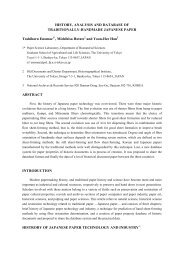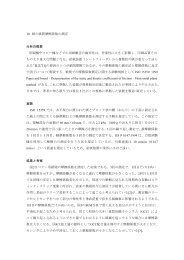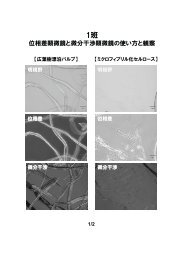APPLICATION OF HOLLOW CALCIUM CARBONATE PARTICLES ...
APPLICATION OF HOLLOW CALCIUM CARBONATE PARTICLES ...
APPLICATION OF HOLLOW CALCIUM CARBONATE PARTICLES ...
You also want an ePaper? Increase the reach of your titles
YUMPU automatically turns print PDFs into web optimized ePapers that Google loves.
66 , , 142-1471999 11 <br />
<br />
<br />
PREPARATION <strong>OF</strong> SPHERICAL <strong>CALCIUM</strong> <strong>CARBONATE</strong> <strong>PARTICLES</strong><br />
AND THEIR <strong>APPLICATION</strong> TO PAPERMAKING<br />
Toshiharu Enomae and Koji Tsujino<br />
Graduate school of Agricultural and Life Sciences<br />
The University of Tokyo<br />
e-mail: enomae@pulpgxa.fp.a.u-tokyo.ac.jp<br />
ABSTRACT<br />
Spherical particles made of calcium carbonate were reported to be available by the interfacial reaction method.<br />
When a potassium carbonate aqueous solution / benzene emulsion at a W/O ratio of 3:7 is poured in a sufficient<br />
volume of calcium chloride solution, spherical and sometimes hollow particles of calcium carbonate develop,<br />
maintaining the shape of emulsified droplets. The surfactant concentration and emulsifying conditions in<br />
dispersion and homogenization determined particle shape, size and distribution. Crystallographically, a portion<br />
of them was in vaterite form and the rest of it was in calcite form. When closely observed in a scanning<br />
electron microscope, individual particles appeared to have a rough surface, packed with fine primary particles<br />
50 nm in diameter. Prepared spherical particles were tried to be applied to paper making as a filler and were<br />
compared with some kinds of ground calcium carbonate and a coagulated precipitated type that are all of the<br />
commercial grade and of a similar particle size. Spherical particles were observed to disperse well within a<br />
sheet together with cubic particles that may have developed from spherical ones during a long dwelling time in<br />
water. Their loading increased specific light scattering coefficient though reduction of sheet density was<br />
suppressed. This effect was greater than other fillers of ground calcium carbonate. The coagulated type<br />
provided the highest increase in light scattering coefficient, presumably because of the high retention. The<br />
effect of the spherical particle is considered to stem from a rough surface, thus leading efficient light scattering.<br />
. 緒 言<br />
<br />
W/O emulsion<br />
Benzene<br />
K 2CO 3 aqueous<br />
removal<br />
<br />
solution<br />
Benzene<br />
Benzene<br />
<br />
<br />
<br />
<br />
CaCl 2 aqueous<br />
solution<br />
Spherical calcium<br />
carbonate particle<br />
<br />
<br />
Fig.1 Predicted mechanism to produce spherical calcium carbonate<br />
particles by the interfacial reaction method.<br />
<br />
1) <br />
1 <br />
<br />
2 <br />
1
66 , , 142-1471999 11 <br />
<br />
<br />
<br />
. 実 験<br />
. 球 状 炭 酸 カルシウム(spherical particles)の 調 製<br />
<br />
polyoxyethylene sorbitan monoolate (Tween-80) 0.5 %<br />
14.5 mL 1 mol/L 6.2 mL W/O <br />
3:7 100 mL 10 <br />
15,000 min -1 10 U0300FB,<br />
26 kHz / 300 W NS-20 <br />
0.2 mol/L 50 mL <br />
2 <br />
1500 G 5 min<br />
1 1 80 %<br />
. 抄 紙<br />
JIS<br />
P8222 LBKP PFI 5000 <br />
PMC polyamideamine-epichlorohydrin resin WS-570<br />
0.1 wt. %<br />
30 wt. % 1500 P-50<br />
H Table 1 Particle properties of calcium carbonate<br />
PCX-850<br />
Mean Specific surface<br />
Filler type<br />
<br />
diameter, µm area, m 2<br />
3<br />
5 <br />
Spherical particles<br />
Softon 1500<br />
3.0<br />
1.5 15.0<br />
1<br />
Whiton P-50 3.2 7.0<br />
Whiton H 5.0 4.5<br />
<br />
PCX-850 3.5 28.0<br />
. シート 特 性<br />
* Some data are based on manufactures' information;<br />
and the others approximately on SEM observation.<br />
g/m 2 g/cm 3 <br />
<br />
m 2 /kg 1 <br />
93.0(1)(2)<br />
2) -<br />
1<br />
SW =<br />
1 R − R<br />
2<br />
( RRgR∞<br />
− RR∞<br />
− Rg<br />
+<br />
ln<br />
2<br />
∞ ∞ ( RRgR∞<br />
− R − RgR∞<br />
+<br />
R<br />
R<br />
∞<br />
∞<br />
)<br />
)<br />
Eq.(1)<br />
2
66 , , 142-1471999 11 <br />
R<br />
c − c<br />
2 − 4<br />
( R<br />
)<br />
g1<br />
+ R2<br />
)( R1R<br />
g 2<br />
−1)<br />
− ( R1<br />
+ Rg<br />
2<br />
)( R2Rg1<br />
−1<br />
∞<br />
= , where c =<br />
and R1<br />
< R2<br />
Eq.(2)<br />
2<br />
R1R<br />
g 2<br />
− R2Rg1<br />
<br />
R <br />
: <br />
R i<br />
: R gi <br />
. i <br />
1 2.<br />
S : <br />
R gi<br />
: i <br />
W : <br />
. 結 果 と 考 察<br />
. 球 状 炭 酸 カルシウム 粒 子 の 性 状<br />
1(a)<br />
2 µm 0.5 µm <br />
34 µm <br />
1(b)<br />
50100 nm <br />
50nm 300 nm <br />
<br />
<br />
<br />
1.5 wt. % 2 <br />
<br />
35 µm 0.51.0 wt. %<br />
95 %<br />
1 µm <br />
3 µm <br />
(a)<br />
(b)<br />
Photo.1 Scanning electron micrographs of spherical particles of calcium carbonate prepared by the<br />
interfacial reaction method (a) and a close-up of a particle surface (b).<br />
<br />
1 µm 100 nm<br />
3
66 , , 142-1471999 11 <br />
3 <br />
<br />
<br />
<br />
<br />
3 <br />
100 % X <br />
<br />
3) <br />
50 %<br />
<br />
<br />
<br />
X-ray counts<br />
Calcite 100 %<br />
Spherical calcium<br />
carbonate<br />
20 22 24 26 28 30 32 34 36 38 40<br />
2 θ , degree<br />
Fig. 3 X-ray diffraction patterns of spherical particles<br />
of calcium carbonate and pure calcite.<br />
. 球 状 炭 酸 カルシウム 粒 子 を 内 添 した 紙 の 特 性<br />
1 <br />
<br />
2 <br />
<br />
<br />
Table 1 Physical and optical properties of carbonate loaded handsheets<br />
<br />
Basis weight, Density, Brightness, Specific scattering<br />
Filler type<br />
<br />
g/m 2 g/cm 3 % coefficient, m 2 /kg<br />
------Trial 1 ------<br />
Spherical particles 69.4 0.622 78.4 37.4<br />
<br />
Softon 1500 70.7 0.623 82.7 37.3<br />
<br />
Whiton P-50 74.0 0.617 82.9 35.3<br />
Whiton H 76.0 0.620 81.1 35.8<br />
Unloaded 68.0 0.633 80.3 35.7<br />
------Trial 2 ------<br />
Spherical particles 65.9 0.675 87.0 35.1<br />
PCX-850 65.6 0.659 82.5 43.9<br />
<br />
Unloaded 62.0 0.684 79.0 32.6<br />
2 <br />
Table 2 Filling effect of calcium carbonate<br />
<br />
Decrease in Increase in specific<br />
Filler type<br />
<br />
density, g/cm 3 scattering coefficient, m 2 /kg<br />
Spherical particles 0.010 2.1<br />
Softon 1500 0.010 1.5<br />
3 <br />
Whiton P-50 0.016 -0.5<br />
1500 <br />
Whiton H 0.013 0.1<br />
PCX-850 0.025 11.3<br />
4
66 , , 142-1471999 11 <br />
P-50 H <br />
PCX-850 <br />
2(e)<br />
<br />
<br />
2(a)(e) 5 <br />
(a)<br />
<br />
(a)<br />
(b)<br />
5 µm<br />
(c)<br />
(d)<br />
Photo.2 Scanning electron micrographs of a<br />
surface of a handsheet loaded with<br />
calcium carbonate. The loaded filler<br />
type is spherical particles (a)<br />
prepared in this work, ground calcium<br />
carbonates Softon 1500 (b), Whiton<br />
P-50 (c) and Whiton H (d), and a<br />
coagulated precipitated type PCX-850<br />
(e).<br />
(e)<br />
5
66 , , 142-1471999 11 <br />
<br />
1500 (b)<br />
10 µm P-50 (c) H (d)<br />
PCX-850 (e)<br />
<br />
<br />
<br />
結 論<br />
<br />
50 nm <br />
<br />
<br />
<br />
謝 辞<br />
10 <br />
<br />
<br />
<br />
文 献<br />
1) , , , “”, <br />
, 1976(5), 732-736<br />
2) Hamada, H., Enomae, T., Onabe, F. and Saito, Y., “Colloidal properties of hollow latices and their roles in<br />
controlling colorimetric parameters of coated paper surface”, Proceedings of Pre-symposium of the 10 th<br />
ISWPC, Korea, 309-314(1999)<br />
3) , “”, , 32(2), 97-104(1995)<br />
6

















